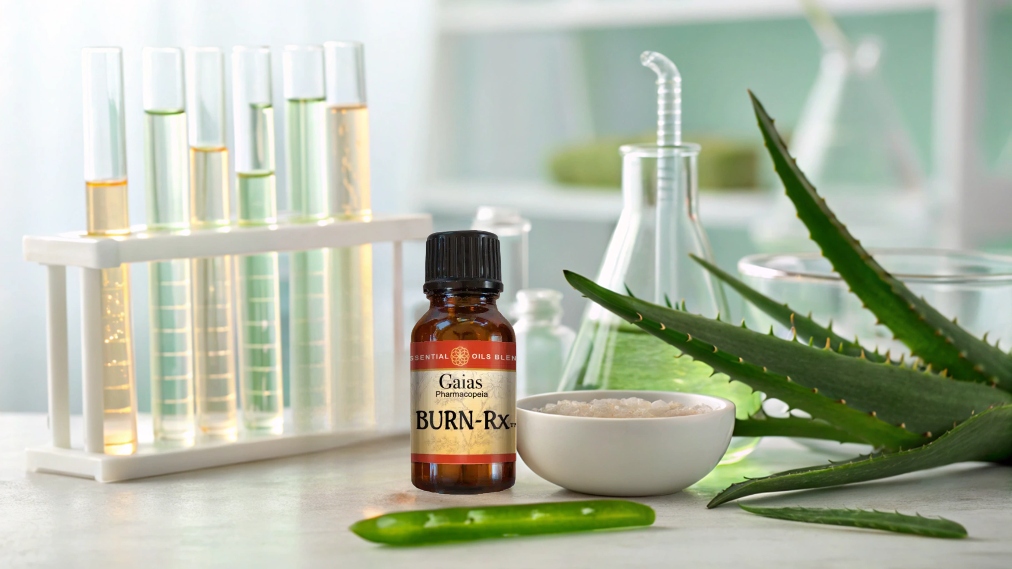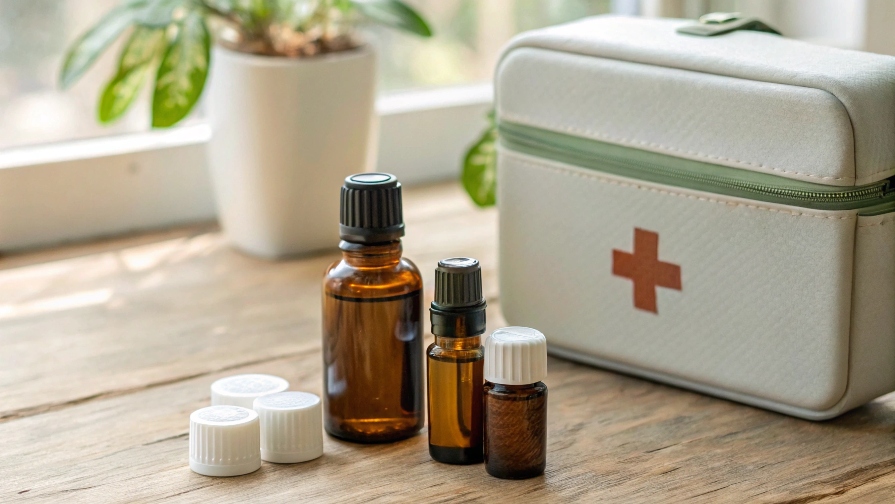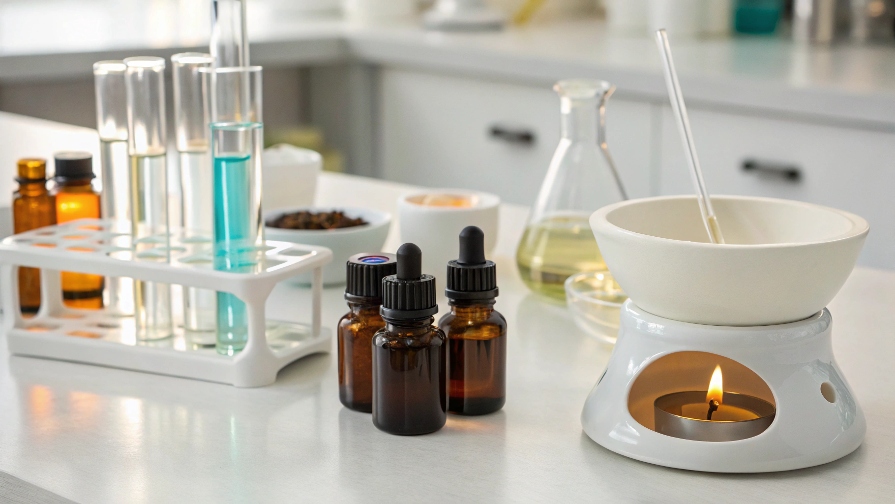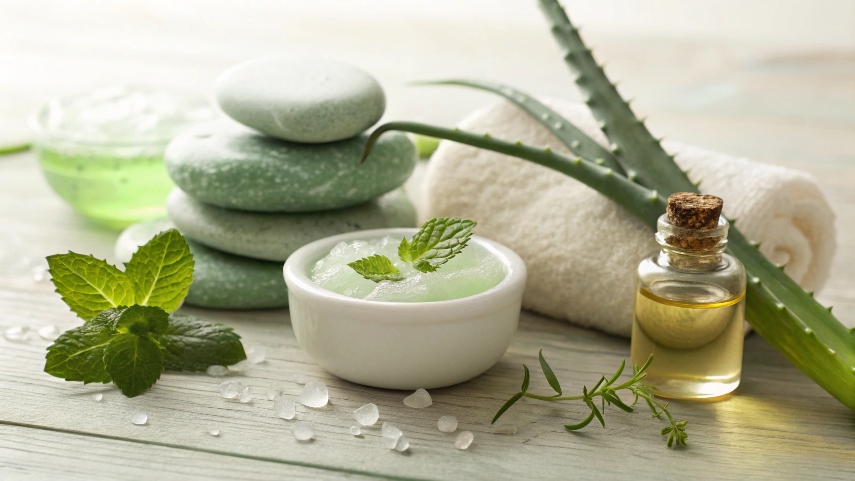Table of Contents - click here
ToggleYou reach for the cast iron skillet handle without thinking. The searing pain hits instantly – that unmistakable burn that makes you gasp and pull your hand away. Your palm throbs as you rush to the sink, heart racing with familiar questions: How bad is this? Will it leave a mark? What should I put on it?
If you’re reading this, you’re likely dealing with a minor burn right now, or you’re a parent, cook, or active person who wants to be prepared for the inevitable kitchen accident or crafting mishap. The good news? You don’t have to resign yourself to weeks of discomfort, slow healing, or permanent scarring.
Natural burn treatment with therapeutic essential oils can accelerate healing while reducing scar formation. As a Certified Clinical Aromatherapist with over 20 years of experience treating burns naturally, I’ve formulated BurnRx specifically to harness nature’s most powerful healing compounds for optimal burn recovery.
This comprehensive guide will show you exactly how to treat minor burns naturally, when it’s safe to use home remedies versus seeking medical care, and how BurnRx’s scientifically-backed formula can transform your burn healing experience. You’ll learn specific application techniques, safety protocols, and realistic healing timelines so you can confidently handle minor burns with professional-level results.
Understanding Minor Burns: When Natural Treatment is Right for You
Before applying any treatment, you need to accurately assess your burn’s severity. This knowledge can mean the difference between successful home treatment and a necessary emergency room visit.
First-Degree vs. Second-Degree Burns: Knowing the Difference
First-degree burns affect only the epidermis (outer skin layer). These burns appear red, feel painful to touch, and may swell slightly. Think sunburn or briefly touching a hot surface – the skin is damaged but remains intact. **These burns are ideal candidates for natural essential oil treatment.**¹
Key characteristics:
- Red, non-blistered skin
- Pain that responds to cooling
- Swelling limited to burn area
- No broken skin or deep tissue damage
Second-degree burns penetrate deeper, affecting both epidermis and partial dermis. These burns often develop blisters, appear red or mottled, and cause significant pain. Minor second-degree burns may respond to natural treatment, but larger ones require professional evaluation.
Safety First: Burns larger than 2 inches in diameter, burns on face/hands/genitals, or any burn with extensive blistering requires immediate medical attention regardless of degree.¹
Common Causes of Minor Burns in Daily Life
Kitchen accidents top the list – grabbing hot handles, splashing boiling water, touching oven racks, or steam burns from pressure cookers. Crafting injuries from glue guns, soldering irons, and heat tools are equally common. Outdoor activities bring risks from campfires, grills, hot car surfaces, and sun exposure.
What makes these everyday burns particularly frustrating is their tendency to linger. That small burn from last week’s cooking accident might still be tender, threatening to leave a permanent mark. This is precisely where proper natural treatment makes the difference between invisible healing and lasting scars.

The Science Behind BurnRx: Why Essential Oils Excel at Burn Healing
Essential oil effectiveness for burn treatment isn’t folklore – it’s validated by peer-reviewed research demonstrating why these concentrated plant compounds can enhance conventional treatments.
Lavender’s Proven Wound Healing Properties
Lavender essential oil serves as the cornerstone of effective burn treatment, backed by compelling research. A comprehensive 2020 systematic review analyzed 36 studies on lavender’s wound healing properties, concluding that “overall, these studies demonstrated a faster rate of wound healing, increased expression of collagen, and enhanced activity of proteins involved in the tissue remodeling process in wounds treated with lavender essential oil.”²
The therapeutic power lies in lavender’s unique chemistry:
- Linalool: Reduces inflammation and provides analgesic effects
- Linalyl acetate: Offers antimicrobial protection and tissue regeneration support
- Active terpenes: Support immune response and cellular repair
A landmark 2016 study demonstrated that topical lavender oil application significantly accelerated wound healing through enhanced collagen synthesis and tissue remodeling, with treated wounds showing measurably decreased areas at multiple time points compared to controls.³ Unlike petroleum-based products that create passive barriers, lavender actively supports cellular regeneration and wound contraction.
Supporting Essential Oils in the BurnRx Formula
BurnRx’s effectiveness comes from synergistic essential oil combinations, each selected for specific therapeutic properties:
Tea Tree Oil (Melaleuca alternifolia): Clinical research demonstrates tea tree oil’s broad-spectrum antimicrobial activity against burn-related pathogens, including methicillin-resistant Staphylococcus aureus (MRSA). A systematic review found tea tree oil effective as adjunctive therapy in treating infected wounds, with studies showing promising results in case reports and small clinical trials.⁴
Helichrysum (Helichrysum italicum): Known as “everlasting flower,” helichrysum contains unique compounds supporting healthy skin regeneration while helping prevent excessive scar tissue formation. This precious oil’s inclusion demonstrates BurnRx’s commitment to optimal healing outcomes.
Frankincense (Boswellia carterii): Traditional wound-healing applications of frankincense are supported by research validating its ability to support healthy cell regeneration and reduce inflammation at the cellular level.
How Essential Oils Enhance Burn Treatment
Conventional approach: Passive wound protection through synthetic barriers, relying primarily on your body’s natural healing mechanisms.
BurnRx approach: Active healing support that works synergistically with your body’s natural processes:
- Antimicrobial properties help prevent infection naturally
- Anti-inflammatory compounds reduce pain and swelling
- Regenerative properties support healthy tissue formation
Research demonstrates that properly applied essential oils can enhance conventional burn treatment outcomes while supporting faster, more comfortable healing.

Ready to experience the healing power of therapeutic-grade essential oils?
Step-by-Step Guide: Using BurnRx for Optimal Burn Healing
Proper application technique determines your healing success. Follow this proven protocol developed through two decades of clinical aromatherapy practice.
Immediate Response: The First 15 Minutes Matter
Your actions in the first 15 minutes significantly impact healing speed and final appearance.
Step 1: Cool the Burn (10-15 minutes)
- Run cool (not cold) water over burned area for 10-15 minutes or until pain subsides⁵
- Water should feel cool but not painfully cold
- If running water unavailable, use cool, wet compresses changed every 2-3 minutes
- Never use ice – this can cause additional tissue damage
Step 2: Assess and Clean
- Gently assess burn severity using guidelines above
- Clean area with mild soap and water if debris present
- Pat dry with clean towel – never rub as this damages tissue
- Remove any jewelry near burn area before swelling occurs
Step 3: First BurnRx Application **For fresh burns, use appropriate dilution ratios based on professional aromatherapy guidelines:**⁶
- Small burn (quarter-size): 3-5 drops BurnRx + 1/2 teaspoon carrier oil (approximately 3% dilution)
- Medium burn (palm-size): 6-8 drops BurnRx + 1 teaspoon carrier oil
- Large burn (hand-size): 10-12 drops BurnRx + 2 teaspoons carrier oil
Recommended carrier oils:
- Fractionated coconut oil (fastest absorption)
- Jojoba oil (closest to skin’s natural oils)
- Sweet almond oil (gentle for sensitive skin)
Apply gently to entire burned area, extending slightly beyond visible damage. Most people experience cooling relief within minutes.
Daily Care Routine for Maximum Healing
Days 1-3: Intensive Healing Phase
- Application frequency: 3 times daily (morning, afternoon, evening)
- Dilution: Continue initial concentration for maximum therapeutic impact
- Coverage: Keep lightly covered with sterile gauze between applications
- Expected progress: Reduced redness, decreased pain, initial healing signs
Healing milestones to expect:
- Day 1: Pain relief, reduced inflammation
- Day 2: Less tenderness, beginning tissue regeneration
- Day 3: Noticeable improvement, healthy tissue formation
Days 4-7: Active Regeneration Phase
- Application frequency: 2 times daily (morning, evening)
- Dilution: May reduce to 2% concentration as healing progresses
- Coverage: May leave uncovered during day if no contamination risk
- Expected progress: Significant improvement in appearance and comfort
Week 2 and Beyond: Scar Prevention Phase
- Application frequency: Once daily, preferably evening
- Technique: Gentle circular massage to promote circulation
- Duration: Continue until skin returns to normal color and texture
Advanced Techniques for Scar Prevention
Gentle Massage Protocol (Week 2+):
- Apply diluted BurnRx to healed area
- Use fingertips to create small, gentle circles
- Start at burn center, work outward
- Apply light pressure – comfort should guide intensity
- Massage for 2-3 minutes, once daily
Sun Protection Protocol:
- First 6 months: Keep healed burns covered when outdoors
- Always apply SPF 30+ broad-spectrum sunscreen to exposed areas
- UV exposure can cause permanent pigmentation changes in healing tissue
Long-term Monitoring: Continue weekly BurnRx applications for 2-3 months after apparent healing to support optimal skin recovery and maintain elasticity.

Safety First: When to Use BurnRx vs. Seeking Medical Care
Your safety always comes first. While BurnRx effectively treats minor burns, recognizing when professional care is necessary protects you from serious complications.
Red Flags Requiring Immediate Medical Attention
**Size and Location Concerns:**¹ ⁵
- Burns larger than 2 inches in diameter
- Burns on face, hands, feet, genitals, or major joints
- Burns encircling limbs, fingers, or toes
- Any burn covering significant body surface area
Severity Indicators:
- White, charred, or leathery appearance
- Deep burns with little or no pain (indicating nerve damage)
- Extensive blistering over large areas
- Burns penetrating through all skin layers
Complication Warning Signs:
- Infection symptoms: Increased redness, warmth, swelling, pus, fever, or red streaking
- High fever accompanying burn
- Worsening pain after initial 48 hours
- No improvement after 3 days of proper treatment
Special Population Considerations:
- Young children: Professional evaluation recommended for burns beyond most minor
- Older adults: Age-related healing complications require monitoring
- Immunocompromised individuals: Higher infection risk necessitates medical oversight
- Diabetics: Slower healing and infection risk require professional guidance
Essential Oil Safety Guidelines
**Dilution Requirements (Critical for Safety):**⁶ ⁷
- Adults: 2-3% dilution for general use (12-18 drops per ounce carrier oil)
- Acute situations: Up to 5% dilution for short-term use (2-3 weeks maximum)
- Children/Sensitive skin: 1% dilution (6 drops per ounce carrier oil)
- Never apply undiluted essential oils to skin
Patch Testing Protocol:
- Mix small amount of diluted BurnRx
- Apply to inner forearm (unburned skin)
- Wait 24 hours
- Check for redness, itching, or irritation
- If any reaction occurs, do not use on burns
Storage and Handling:
- Store in cool, dark location
- Keep away from children and pets
- Use dark glass containers to protect from light
- Replace if oils smell off or have changed color significantly
For comprehensive essential oil safety information, review our beginner’s guide to essential oil use.

Supporting Research on Essential Oil Burn Treatment
The clinical evidence supporting essential oils for burn treatment continues expanding. Multiple peer-reviewed studies have examined essential oils for wound healing, with systematic reviews concluding that properly formulated blends can provide significant benefits for minor burns.
Key research findings include:
- Lavender oil’s documented wound healing properties through enhanced collagen synthesis and cellular regeneration²
- Tea tree oil’s proven antimicrobial activity against common wound pathogens including antibiotic-resistant strains⁴
- Essential oil treatments showing improved healing outcomes in clinical studies and case reports
- Enhanced pain relief and better cosmetic results with proper essential oil protocols
A 2020 systematic review of 36 studies found that “the current body of literature suggests a potential therapeutic benefit of lavender essential oil in wound healing,” while noting the need for standardization and additional high-quality clinical trials.² Recent research continues validating the therapeutic mechanisms of essential oils in wound healing, supporting their traditional uses with modern scientific understanding.
This research supports what thousands of BurnRx users experience: enhanced healing outcomes, improved comfort, and better cosmetic results when therapeutic-grade essential oils are applied correctly with proper safety protocols.
Beyond Burns: Additional Uses for Your BurnRx Blend
BurnRx’s versatility extends well beyond burn treatment, making it a valuable addition to any natural first aid arsenal.
Minor Cuts and Scrapes: BurnRx’s antimicrobial and healing properties excel at treating small wounds. Apply the same dilution protocols used for burns to clean cuts for enhanced healing support.
Sunburn Relief: Sunburn represents first-degree burn from UV radiation. BurnRx provides cooling relief while supporting natural healing processes. Many users report improved comfort and faster healing.
Kitchen First Aid Applications: Beyond obvious burns, kitchens present various injury risks. Steam burns, knife cuts, and scrapes all respond well to BurnRx treatment. Keep a pre-diluted bottle readily accessible for immediate accident response.
Post-Surgical Wound Support: Always follow surgeon’s specific instructions first. Many healthcare providers approve therapeutic essential oils for supporting minor surgical site healing. BurnRx can help reduce inflammation and support optimal healing when used with medical approval.
For comprehensive natural first aid guidance, explore our complete essential oils for injuries guide.
FAQs: Your Most Common BurnRx Questions Answered
1. How quickly can essential oils heal a minor burn?
Most people experience pain relief within minutes of BurnRx application. Visible healing typically begins within 24-48 hours, with minor burns often healing completely within one to two weeks, depending on severity and individual healing factors.
2. What essential oils are safe to use directly on burns?
Never apply any essential oil directly to burns without proper dilution. Even therapeutic-grade oils like those in BurnRx must be diluted in carrier oils at 2-3% concentration for adults. Pure essential oils can worsen burn damage due to their concentrated nature.
3. Can BurnRx prevent scarring from kitchen burns?
When used properly and consistently from the initial injury, BurnRx’s essential oils actively support healthy collagen formation while helping prevent excessive scar tissue development. Research shows lavender oil enhances wound healing and tissue remodeling processes that reduce scarring potential.
4. How do you properly dilute essential oils for burn treatment?
Follow professional aromatherapy guidelines: Use 2-3% dilution for adults (12-18 drops per ounce carrier oil), 1% for children and sensitive skin (6 drops per ounce). Always mix thoroughly and store in dark glass containers.
5. When should I see a doctor instead of treating a burn at home?
Seek medical care for burns larger than 2 inches, burns on face/hands/genitals, burns with extensive blistering, signs of infection (fever, pus, increasing redness), or any burn that doesn’t improve within 2-3 days.
6. What’s the difference between first-degree and second-degree burns?
First-degree burns affect only the skin’s surface, appearing red and painful without blisters. Second-degree burns penetrate deeper, often forming blisters and causing more severe pain. BurnRx works best on first-degree burns and minor second-degree burns.
7. Are essential oils better than aloe vera for minor burns?
Both have benefits, but BurnRx offers advantages aloe vera alone cannot provide. While aloe vera cools and moisturizes, BurnRx actively helps prevent infection, reduces inflammation, and supports cellular regeneration. Many users combine both approaches for maximum benefit.
8. How long should I keep a burn covered during healing?
Keep burns loosely covered with sterile gauze for the first few days to protect from contamination and retain moisture. Once new skin begins forming, you can leave uncovered during the day, covering only when risk of contamination exists.
9. Can I use essential oils on burns with blisters?
Small, intact blisters can be treated with diluted BurnRx applied around (not directly on) the blister. Never intentionally break blisters as this increases infection risk. Large or numerous blisters require medical evaluation.
10. What ingredients should I avoid putting on a fresh burn?
Never use: ice, butter, oils, toothpaste, egg whites, or folk remedies on fresh burns. These can trap heat, cause infection, or delay healing. Use only cool water initially, followed by properly diluted therapeutic essential oils.
For additional safety and application guidance, visit our essential oil safety resource.
Your Path to Enhanced Burn Healing Starts Now
You don’t have to accept slow healing and unnecessary scarring from minor burns. The difference between weeks of discomfort and optimal healing often comes down to the treatment you choose in those crucial first hours after injury.
BurnRx represents more than just another burn remedy – it’s a research-backed approach to active healing support. When you choose therapeutic essential oils formulated by a Certified Clinical Aromatherapist, you’re choosing a treatment that works synergistically with your body’s natural healing mechanisms rather than simply masking symptoms.
Consider the limitations of basic burn treatment:
- Extended healing time means prolonged discomfort
- Higher risk of suboptimal scarring outcomes
- Limited active healing support
- Potential for complications without proper care
Compare this to the BurnRx advantage:
- Research-supported healing enhancement
- Professional-grade essential oil formulation
- Natural antimicrobial protection
- Active support for optimal tissue regeneration
Every moment you delay implementing proper burn care is time your skin could be healing more effectively. The next kitchen accident or minor burn doesn’t have to become a lasting reminder on your skin.
Transform Your Burn Care Today – Get BurnRx and experience nature’s powerful healing support when properly harnessed through professional aromatherapy expertise.
Have questions about using essential oils for burn treatment? Wondering if BurnRx is right for your specific situation? Share your concerns in the comments below – your questions help others make informed decisions about natural burn care.
Cynthe Brush
Certified Clinical (Medical) Aromatherapist
Creating Custom Blends Since 1999
800-307-3564
Therapeutic Essential Oils Practitioner & Self-Care Health Educator has used essential oils for personal, family, & client health issues for over 20 years.
References and Sources
Here are the properly formatted citations with complete source information:
Samuelson, R., Lobl, M., Higgins, S., Clarey, D., & Wysong, A. (2020). The Effects of Lavender Essential Oil on Wound Healing: A Review of the Current Evidence. Journal of Alternative and Complementary Medicine, 26(8), 680-690.
Mori, H. M., Kawanami, H., Kawahata, H., & Aoki, M. (2016). Wound healing potential of lavender oil by acceleration of granulation and wound contraction through induction of TGF-β in a rat model. BMC Complementary and Alternative Medicine, 16, 144.
Halcón, L., & Milkus, K. (2004). Staphylococcus aureus and wounds: A review of tea tree oil as a promising antimicrobial. American Journal of Infection Control, 32(7), 402-408.
Edmondson, M., Newall, N., Carville, K., Smith, J., Riley, T. V., & Carson, C. F. (2011). Uncontrolled, open-label, pilot study of tea tree (Melaleuca alternifolia) oil solution in the decolonisation of methicillin-resistant Staphylococcus aureus positive wounds and its influence on wound healing. International Wound Journal, 8(4), 375-384.
Carson, C. F., Hammer, K. A., & Riley, T. V. (2006). Melaleuca alternifolia (tea tree) oil: a review of antimicrobial and other medicinal properties. Clinical Microbiology Reviews, 19(1), 50-62.






